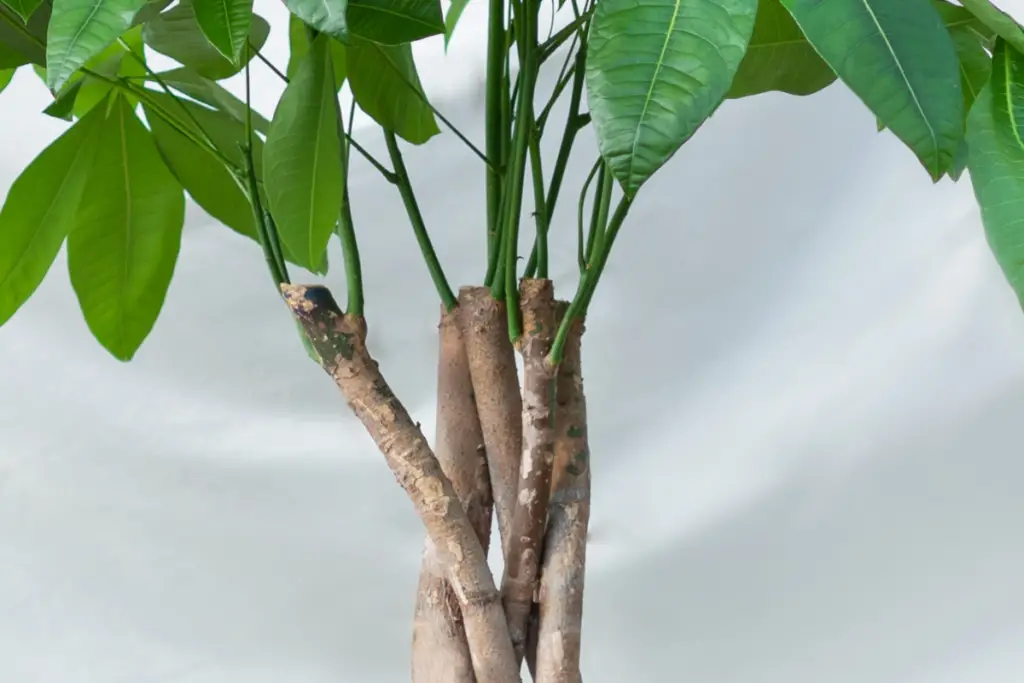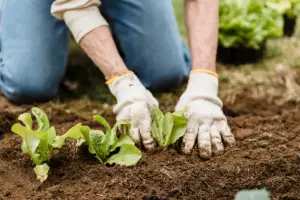The Money Tree plant is a popular indoor plant that is known for its attractive foliage and easy care.
However, if not properly cared for, the Money Tree can become stressed and show signs of underwatering.
Signs of underwatering in a Money Tree can include wilting leaves, dry soil, and brown and crispy leaf edges.
If you notice any of these signs, it is important to take action to revive your Money Tree. Reviving an underwatered Money Tree involves careful watering and maintenance.
It is important to water the plant when the top inch of soil has dried out and keep it in a location with bright indirect light and consistent humidity.
By following these steps, you can help your Money Tree recover and thrive.

Table of Contents
Understanding Money Tree Plant
Origin and Characteristics
The Money Tree Plant (Pachira aquatica) is native to Central and South America. It is also known as Malabar Chestnut, Guiana Chestnut, or Saba Nut.
The plant is a small tree that can grow up to 60 feet tall in its natural habitat. The Money Tree Plant has a distinctive braided trunk and glossy green leaves that can grow up to 12 inches long.
The plant produces small, white flowers that eventually turn into fruit that resembles a chestnut.
The Money Tree Plant is a popular houseplant due to its attractive appearance and reputation for bringing good luck and prosperity.
It is easy to care for and can thrive in a variety of conditions. However, it is important to note that the Money Tree Plant is toxic to pets if ingested.
Importance of Adequate Watering
Adequate watering is crucial for the health and well-being of the Money Tree Plant. Overwatering or underwatering can cause significant damage to the plant and even lead to its death.
Signs of underwatering include dry and brittle leaves, wilting, and curling of leaves. On the other hand, overwatering can cause root rot, which is characterized by yellowing and softening of leaves, and the plant may eventually wilt and die.
To properly water the Money Tree Plant, it is important to check the soil’s moisture levels regularly. The soil should be damp, but not waterlogged.
The plant requires watering when the soil is dry to the touch. It is important to note that the frequency of watering will depend on the plant’s environment, such as the temperature, humidity, and amount of sunlight it receives.
In summary, the Money Tree Plant is an attractive and easy-to-care-for houseplant that requires adequate watering for its optimal growth and health.
It is important to monitor the soil’s moisture levels regularly and avoid overwatering or underwatering the plant.
Signs of Underwatered Money Tree
When it comes to caring for a money tree, one of the most important things to keep in mind is watering.
Overwatering or underwatering the plant can cause serious damage, and it’s essential to know the signs of both. In this section, we will discuss the signs of an underwatered money tree.
Wilting Leaves
One of the first signs that a money tree is not getting enough water is wilting leaves. The leaves of an underwatered money tree will start to droop and wilt, and they may even curl up at the edges.
This happens because the plant is trying to conserve water by reducing the amount of surface area that is exposed to the air.
Yellowing Leaves
Another sign of an underwatered money tree is yellowing leaves. When the plant is not getting enough water, the leaves will start to turn yellow and may even fall off.
This happens because the plant is not able to absorb the nutrients it needs from the soil, and the leaves are not getting the water they need to stay healthy.
Slow Growth
A money tree that is underwatered will also show signs of slow growth. The plant may stop producing new leaves or may produce them at a much slower rate than usual.
This happens because the plant is not getting the nutrients it needs to grow and thrive.
In summary, an underwatered money tree will show signs of wilting leaves, yellowing leaves, and slow growth.
It’s essential to keep an eye out for these signs and to water the plant when necessary to ensure that it stays healthy and vibrant.
How to Revive an Underwatered Money Tree
If you notice that your money tree is underwatered, don’t worry, it’s not too late to save it.
Here are some immediate watering measures and a long-term care plan to help revive your plant.
Immediate Watering Measures
When you first notice that your money tree is underwatered, the best thing to do is to give it a thorough watering.
Use a watering can or a hose to water the soil until it is wet all the way through. Be sure to water until the water drains out of the bottom of the pot.
If the soil is very dry, it may be difficult for the water to penetrate the soil. In this case, you may need to submerge the pot in a bucket of water for a few minutes to allow the soil to absorb the water. After watering, be sure to remove any excess water from the saucer under the pot to prevent root rot.
Long-Term Care Plan
To prevent your money tree from becoming underwatered again, it’s important to establish a long-term care plan. Here are some tips to help you care for your plant:
- Water your money tree regularly, but be careful not to overwater it. Check the soil moisture level by sticking your finger into the soil up to the second knuckle. If the soil feels dry at that depth, it’s time to water.
- Use a well-draining soil mix that allows excess water to drain away from the roots. Avoid using heavy soils that retain water, as this can lead to root rot.
- Provide your money tree with adequate light. Money trees prefer bright, indirect light, but can also tolerate low light conditions.
- Keep your money tree away from drafts and extreme temperatures. Money trees prefer temperatures between 60-75°F (15-24°C) and can be damaged by cold drafts or hot, dry air.
By following these tips, you can help revive your underwatered money tree and prevent it from becoming stressed in the future.
Preventing Future Underwatering
To prevent future underwatering of a Money Tree, there are a few things to keep in mind.
First, it is important to establish an ideal watering routine.
Secondly, it is essential to keep an eye out for signs of underwatering.
Ideal Watering Routine
The ideal watering routine for a Money Tree is to water it when the top inch of soil is dry. This can be determined by sticking a finger into the soil or by using a moisture meter.
It is crucial not to overwater the plant, as this can lead to root rot, which can be fatal to the plant.
On the other hand, underwatering can cause the plant to wilt and eventually die.
When watering a Money Tree, it is essential to water it thoroughly. This means watering until the water drains out of the bottom of the pot. It is also important to allow the top inch of soil to dry out before watering again.
Over time, it is possible to establish a watering routine that works best for the plant.
Signs to Watch For
To prevent underwatering, it is crucial to keep an eye out for signs that the plant is not getting enough water.
One of the most common signs of underwatering is dry soil. If the soil is dry to the touch, it is a sign that the plant needs water.
Another sign of underwatering is brown spotting on the leaves. These spots won’t have a yellow halo (a sign of overwatering) and show up because the leaf is beginning to die.
If you continue to let the plant dehydrate, these spots will become necrotic, and the leaf will have to be removed.
By establishing an ideal watering routine and keeping an eye out for signs of underwatering, it is possible to prevent future damage to a Money Tree.
With proper care, a Money Tree can thrive and add beauty to any indoor space.
Conclusion
In conclusion, an underwatered money tree can be revived with proper care and attention. It is important to identify the signs of an underwatered money tree, such as dry, brown leaves and a lack of new growth.
Once the problem has been identified, it is crucial to take immediate action to prevent further damage.
To revive an underwatered money tree, the first step is to water it thoroughly. It is recommended to place the entire plant, pot and all, in a tub or sink and add water around it.
This will ensure that the soil is evenly moistened and the roots have a chance to absorb the water they need.
After watering, it is important to monitor the plant closely and ensure that it is not overwatered.
Overwatering can be just as damaging as underwatering, so it is important to strike a balance and provide the plant with just the right amount of water.
In addition to proper watering, it is important to ensure that the money tree is placed in a suitable environment.
This includes providing it with adequate light, avoiding extreme temperatures, and ensuring proper drainage. With proper care, an underwatered money tree can be revived and thrive once again.
- How to Dry Basil Leaves: A Professional Guide
- Is an Avocado a Fruit or Vegetable? Simple Answer and Explanation
- Does Pineapple Have Seeds? Exploring the Anatomy of Pineapples
- Blooming Through Winter: Can I Grow Vegetables Indoors in the Winter?
- What Can You Grow in a Greenhouse All Year Round: A Guide to Year-Round Greenhouse Gardening
- Are Blueberries Blue? Debunking the Myth of Their Color

















